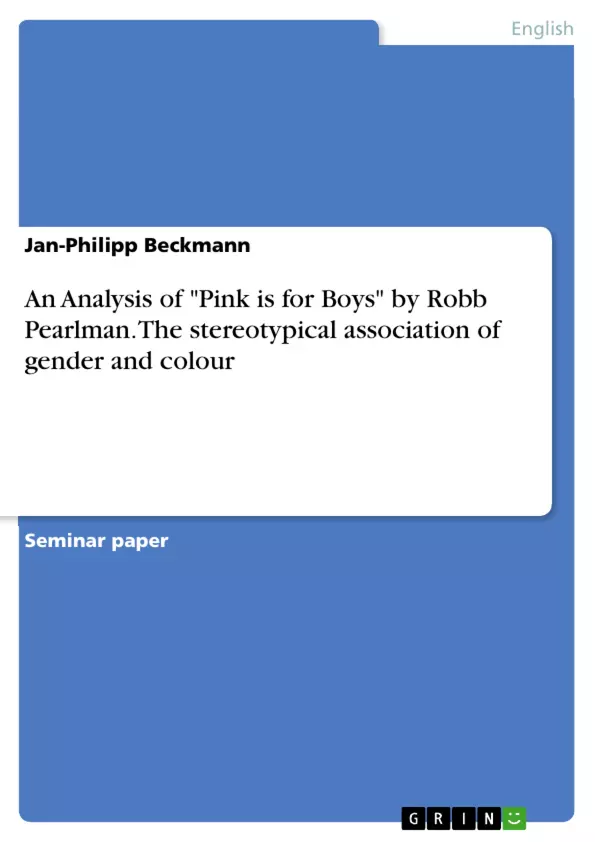The picture book Pink is for boys, written by Robb Pearlman and illustrated by Eda Kaban focuses on breaking up stereotypical associations between certain colours and gender. Children start to explore their sexuality and their gender in primary school, where they will be confronted with certain expectations connected to their gender.
This term paper will focus on the how the book tackles such a sensible topic. The first chapter functions as an opener into the broad field of gender stereotypical associations that are connected to certain colours. The third chapter solely focuses on the analysis of the picture book while highlighting the importance of this topic, just like the second part of this term paper. The last segment emphasises the importance of talking about gender stereotypes and the possible implementation of this book, as an opener, in class.
As we have seen, many children articulated personal struggles and pressures in trying to get their gender/sexuality “right” and most had, at one time or another, been subject so some form of gender-based or sexualised teasing (or Othering) for stepping outside of failing to project appropriate ”masculinities” or “femininities”. (Renold 2015)
Bullying has always been a huge part of everyone’s school life. Either on the receiving end or the distributing end. Those who experience bullying at first hand are mostly classified as different in comparison to the social norm. Some kids who openly display non stereotypical aspects of their gender such as sports, fashion, hobbies in general or - to sum it up, what they like, are often targeted by “normal” kids for their otherness (ibid.). Therefore talking about gender stereotypes should be part of the syllabus in primary school. This picture book can be used as an opener in class to tackle a part of this issue by talking about the message of Pink is for boys.
Inhaltsverzeichnis (Table of Contents)
- Introduction
- Social Norms and Stereotypical Gender Associations
- The analysis of Pink is for boys
- The Structure of the Picture Narration
- The Pictorial Narration
- Talking about Gender Stereotypes
- Conclusion
Zielsetzung und Themenschwerpunkte (Objectives and Key Themes)
This term paper analyzes the picture book "Pink is for Boys" by Robb Pearlman and Eda Kaban, examining how it addresses stereotypical gender associations with colors. The paper explores the book's structure and message, considering its effectiveness in challenging societal norms surrounding gender and color preferences. The analysis also discusses the importance of addressing gender stereotypes in primary school education, suggesting the book as a potential tool for initiating these conversations.
- Stereotypical gender associations with colors, particularly pink and blue.
- The role of picture books in challenging societal norms.
- The impact of social expectations on children's gender identity development.
- The importance of discussing gender stereotypes in primary school.
- Analysis of the structure and pictorial narration of "Pink is for Boys."
Zusammenfassung der Kapitel (Chapter Summaries)
The introduction sets the context by discussing the prevalence of gender stereotypes and their impact on children. It highlights the book's aim to challenge these associations. The second chapter delves into social norms and stereotypical gender associations linked to colors, examining the psychological effects of these connections and the lack of scientific evidence supporting inherent color preferences based on gender. The third chapter analyzes "Pink is for Boys," focusing on its unique structure as a picture narrative with minimal text, and exploring how the verbal and visual elements work together to convey its message. This section does not contain a summary of the conclusion.
Schlüsselwörter (Keywords)
Gender stereotypes, color associations, children's literature, picture books, gender identity, primary school education, social norms, "Pink is for Boys," Robb Pearlman, Eda Kaban, pictorial narration, challenging stereotypes.
- Citation du texte
- Jan-Philipp Beckmann (Auteur), 2023, An Analysis of "Pink is for Boys" by Robb Pearlman. The stereotypical association of gender and colour, Munich, GRIN Verlag, https://www.grin.com/document/1519171



